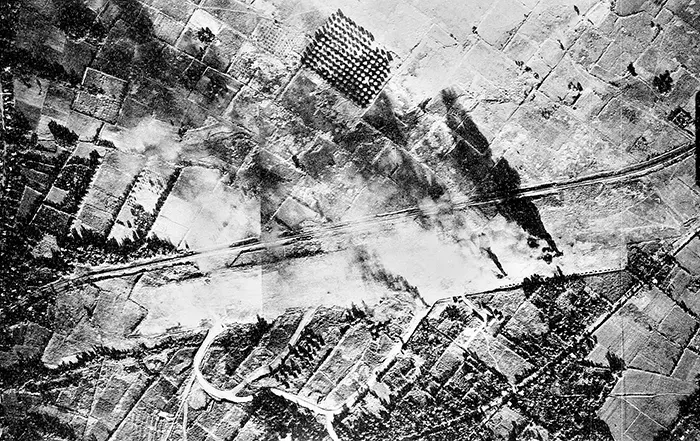[PHOTOS] Lipa and Batangas Airfields after 1944 US Raids in World War II
There were two airfields built and operated by the United States Army in the province of Batangas prior to the outbreak of World War II in the Pacific — one in the then-town of Batangas and the other in the municipality of Lipa less than twenty kilometers to the north.
The one in Batangas Town, which used to be in what is now partly the area of Camp Miguel Malvar of the Philippine National Police, was at one time even used as a commercial airport and was operated by the Philippine Army Air Corps (PAAC) before the invasion of the Japanese Imperial Army on 8 December 1941.
The one in Lipa was hastily built by the United States Army in anticipation of war but just as hastily abandoned after the Japanese invasion, as “War Plan Orange1,” otherwise known as the retreat to the Bataan Peninsula, was put into action upon the orders of General Douglas MacArthur.
Both airfields were subsequently taken over by the air wing of the Japanese Imperial Army. Lipa Airfield would subsequently be upgraded by the United States Army who would, in 1948, turn it over to the fledgling Philippine Air Force. It is presently known as Basilio Fernando Air Base.
There was another airfield built very close to Lipa Airfield which in Japanese documents was referred to as “Lipa East Airfield.” This was supposed to have been a sod or grass auxiliary airstrip, as opposed to Lipa West, which was concrete.
In many US Army documents, reference was made to a “Calingatan Airfield,” so it is possible that this was the same airfield that the Japanese referred to as “Lipa East.” However, as a word of caution, photographs labeled as “Lipa Airfield” by some American documents are called “Calingatan Airfield by others.”
The two airstrips were actually very close to each other and the naming discrepancy might have been a simple case of military intelligence available to those who prepared the reports. For the purposes of this article, however, what is named as the “Calingatan Airfield” in the photograph we shall construe to actually be the Lipa Airfield.
By late 1944, however, the United States Army and its allies were firmly esconced on the island of Leyte and were executing air operations against Japanese military camps in Luzon in preparation for landings in southern Mindoro in December of the same year and Lingayen and Nasugbu the following month.
From the operations report2 of Task Group 38.1, commanded by Rear Admiral Alfred E. Montgomery, we get two photographs taken by raiding planes flying from the light aircraft carrier USS Cabot during raids on both Lipa and Batangas airfields.
The instructions given to the raiding aircraft were: “...to bomb and strafe planes on the ground and remain over the target area as combat air patrol until approximately the time of arrival of the next strike3.”
These air strikes, therefore, were intended to further cripple Japanese air capabilities already severely weakened after the so-called “Great Marianas Turkey Shoot,” as the Battle of the Philippine Sea was humorously referred to by American personnel4.
Both Lipa and Batangas Airfields were considered by the United States military as “secondary airfields,” meaning that they had “servicing facilities and minor repair facilities5.” In contrast, the Nielson Airfield in Makati and Nichols Airfield in Pasay6 were categorized as “major airfields” with “complete servicing and repair facilities.”
Below are the pictures taken of Batangas and Lipa Airfields as extracted by the report of Task Group 38.1. The captions provided underneath each picture are as they were given in the report.
 |
| Original Caption: "Wasp (USS) 345 14 Dec. 44 2330 OCT-9 K-17-12" 6,000' Batangas Field, Luzon, P.I. Confidential Run #7." |
2 “Action Report, Operations Against Luzon Airfields and Shipping, during the period 10 to 24 December 1944,” by the Commander Task Group 38.1, online at the United States National Archives Digital Library.
3 Ibid.
4 “Battle of the Philippine Sea,” Wikipedia.
5 Op. cit.
6 Presently known as Villamor Air Base of the Philippine Air Force.

